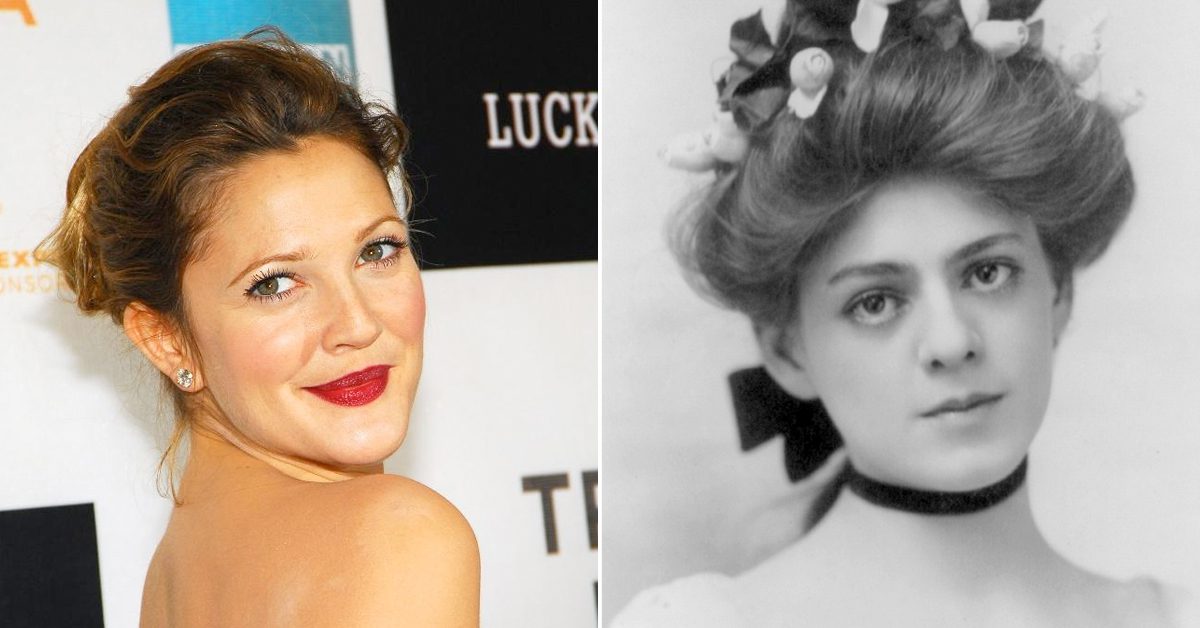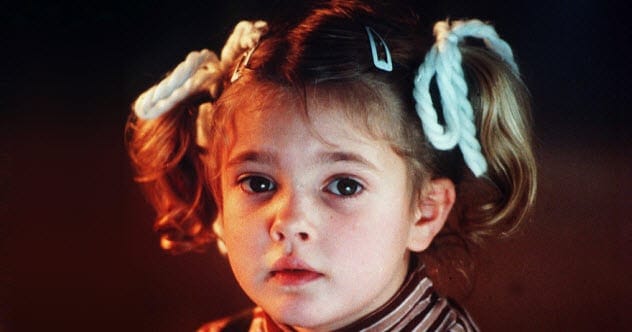Drew Barrymore, a name synonymous with Hollywood charm and resilience, hails from a lineage steeped in theatrical greatness. While many know her as the granddaughter of the legendary John Barrymore Sr., fewer are aware of the striking parallels she shares with his sister, Drew’s great-aunt, Ethel Barrymore. Dubbed the “First Lady of the American Theater,” Ethel was a titan of her time. Though born 96 years apart, these two Barrymore women navigated remarkably similar paths. Let’s explore 10 surprising things Drew Barrymore has in common with the iconic Ethel Barrymore.
10. Born into an Acting Dynasty
It’s no secret that Drew Barrymore was born into what’s often called Hollywood’s “Royal Family.” Her grandfather, John Barrymore Sr., was a celebrated actor, famed for his stage roles in Hamlet and Richard III, and films like Grand Hotel. His siblings, Ethel and Lionel, also boasted illustrious acting careers.
This theatrical legacy, however, goes back even further. Their parents, Maurice Barrymore and Georgiana Drew, and maternal grandparents, John Drew Sr. and Louisa Lane Drew (respected actor/theater managers), were all part of this dynasty. This makes Drew Barrymore at least a sixth-generation actor. Both Drew and Ethel grew up under the considerable shadow and expectations of this iconic family heritage.
9. Independent from a Young Age
Drew Barrymore’s unconventional childhood and early rise to fame are well-documented. Shockingly, she took on adult responsibilities at a very young age, becoming legally emancipated at 14. While a daunting step, Drew has acknowledged it was a necessary decision at the time, recommended by professionals at a mental health facility she entered at 13 as her life spiraled.
Ethel faced a similar early thrust into responsibility. Just before her 14th birthday, her mother, Georgiana Drew, passed away. A devastated Ethel had to mature quickly, not only caring for herself but also for her brothers, Lionel and John. Financial pressures, exacerbated when her grandmother ceased managing Philadelphia’s Arch Street Theatre, forced Ethel to abandon her dreams of becoming a concert pianist. She had to enter the family profession, touring with her uncle’s company and living alone in boarding houses while still a minor.
8. Striking Physical Resemblance

The physical likeness between Drew and Ethel Barrymore is truly startling. While family resemblance is expected, the similarity is particularly noteworthy given Drew is Ethel’s great-niece, not a direct descendant.
Many widely seen photos of Ethel are from her later, more matronly years. However, when you look at pictures of her as a young woman, the resemblance to Drew is incredibly clear, sometimes even uncanny. Their shared features are a testament to the strong Barrymore genes.
7. Challenges in Romantic Relationships
Drew Barrymore has navigated numerous high-profile relationships, including three marriages and at least two broken engagements. Her first marriage, at 19, to Jeremy Thomas, lasted from 1994 to 1995. Her second, to comedian Tom Green, was from 2001 to 2002. In 2016, Drew and art consultant Will Kopelman, with whom she has two daughters, divorced after nearly four years. Drew has stated she doesn’t plan to marry again but might consider living with someone.
Ethel’s love life also had its complexities. She married Russell Griswold Colt, a millionaire’s son, in 1909 and had three children with him. Before this, she had two broken engagements and many suitors. Ethel and Colt separated after 11 years and divorced a few years later. Though only in her forties at the time of her divorce, Ethel Barrymore never remarried.
6. Media Darlings of Their Eras
Since her breakout role as Gertie in E.T. the Extra-Terrestrial (1982), Drew Barrymore has been a media fixture. As she evolved into a pop culture icon, her career and personal life—her romances, struggles, and transformation into a thriving actress, filmmaker, and mother— consistently made headlines.
Similarly, the press in Ethel Barrymore’s era showered her with attention. Her love life was a popular topic. According to her autobiography, upon returning to America after working in England, Ethel found her romances had become sensationalized fodder for newspapers. This extensive coverage continued throughout her life, with Ethel gracing the covers of magazines like Time, Ladies Home Journal, and a 1923 issue of McCall’s.
5. A Surprising Love for Baseball
Ethel Barrymore was a known and avid baseball fan. This passion, along with her enthusiasm for boxing, might seem surprising given her regal and sophisticated public image. A 1942 article in The Milwaukee Journal noted: “She can quote baseball averages almost as well as her lines in ‘The Corn is Green.’”
Drew Barrymore starred in the popular baseball-themed romance, Fever Pitch (2005), playing a woman who falls for a die-hard Red Sox fan. Drew admitted she was new to baseball when filming began but developed a genuine appreciation for the sport and Red Sox fervor, saying at the premiere, “I love Boston, I love the team… It’s just great.”
4. Battling Addiction Issues
The Barrymore family has, over generations, become known for struggles with alcohol and drug addiction, often dubbed “The Barrymore Curse.” Drew’s battles with addiction, beginning in her childhood, were public and chronicled in her 1990 memoir, Little Girl Lost. Importantly, Drew successfully overcame her addiction and now leads a healthy life. Sadly, this wasn’t the case for several family members, including her grandfather, whose addiction was destructive.
Ethel Barrymore’s struggles with alcohol are less widely known than those of other family members, but she wasn’t immune. She eventually confronted her alcoholism. According to the Los Angeles Times, “Ethel, at 60, finally faced her alcoholism and stopped drinking, abruptly and forever.”
3. Remarkable Acting Versatility
Following in the comedic footsteps of ancestors like Georgiana Drew and John Drew Sr., Drew is celebrated for her comedic roles in films such as Never Been Kissed, Music & Lyrics, 50 First Dates, and Charlie’s Angels. However, she has also demonstrated significant versatility with critically acclaimed dramatic performances in Everybody’s Fine and Grey Gardens, as well as in suspense films like Scream.
Ethel Barrymore is perhaps best remembered for dramatic roles, including her Academy Award-winning performance in the 1944 film None but the Lonely Heart. Yet, she excelled in a wide array of characters. Her obituary in The Norwalk Hour noted, comparing her to her brothers: “Ethel was the most versatile, ranging from light comedy to tragedy with equal skill.” She also showcased her talent for suspense in films like The Spiral Staircase, earning another Oscar nomination.
2. Navigating Life with Absentee Fathers

Both Drew and Ethel experienced childhoods with largely absent fathers who were also actors. In 2014, The Daily Express quoted Drew saying: “My parents split up before I was born, and my dad was just never capable of being a father.”
Drew accepted her unconventional father, John Barrymore Jr., but admitted wishing for a more traditional paternal figure. After becoming a mother, she found it harder to understand his choices. However, she did grow closer to him in his final years while caring for him in hospice.
Ethel and her brothers were often left in others’ care due to their parents’ frequent touring. After her mother’s death, Ethel’s father remarried quickly, and she saw little of him. She even learned of his remarriage from a newspaper clipping shown to her at boarding school. Tragically, Ethel later had to arrange for her father’s care in mental institutions after he suffered from syphilis-induced insanity.
1. A Penchant for Partying
The Barrymore women certainly knew how to enjoy themselves. Drew’s “wild child” partying lifestyle during her youth, famously frequenting venues like Studio 54 as a child, was heavily covered. As reported by The Guardian, Drew herself admits she was a “party girl” from the age of eight, going out with her mother and her mother’s friends multiple times a week.
While the Victorian era was more subdued, young Ethel was a popular and fun-loving socialite. She was a favored guest among the aristocracy and recalled many lively outings with prominent figures in her autobiography. She particularly reminisced about house parties in England at the estates of her high-society friends, showcasing a vibrant social life respective of her time.
The parallels between Drew Barrymore and her great-aunt Ethel are numerous and profound, painting a picture of two exceptionally talented women navigating fame, family legacy, and personal challenges across different generations. Their shared experiences offer a fascinating glimpse into the enduring spirit of the Barrymore dynasty.
What other similarities have you noticed between these iconic actresses, or perhaps with other members of the Barrymore family? Share your thoughts in the comments below!










